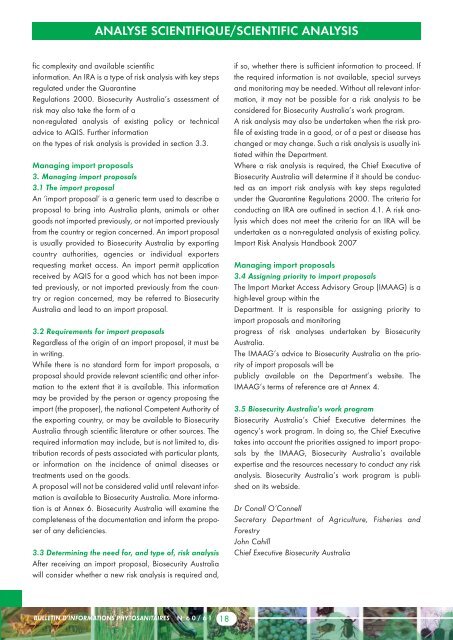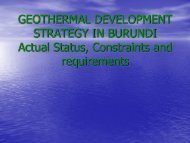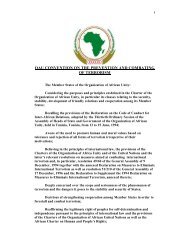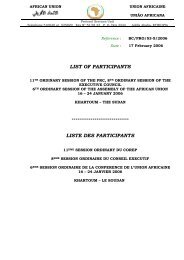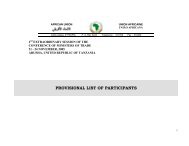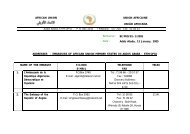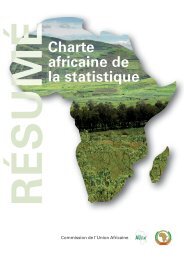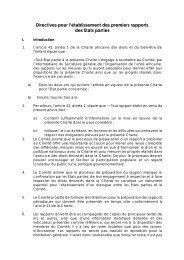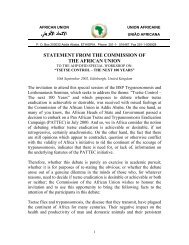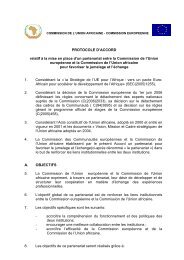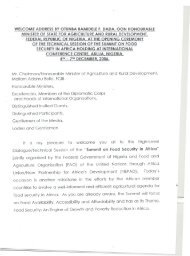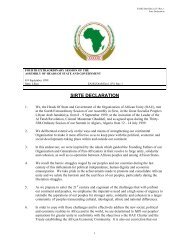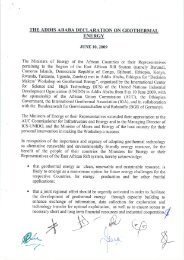BULLETIN D'INFORMATIONS PHYTOSANITAIRES ... - Union africaine
BULLETIN D'INFORMATIONS PHYTOSANITAIRES ... - Union africaine
BULLETIN D'INFORMATIONS PHYTOSANITAIRES ... - Union africaine
- No tags were found...
You also want an ePaper? Increase the reach of your titles
YUMPU automatically turns print PDFs into web optimized ePapers that Google loves.
ANALYSE SCIENTIFIQUE/SCIENTIFIC ANALYSISfic complexity and available scientificinformation. An IRA is a type of risk analysis with key stepsregulated under the QuarantineRegulations 2000. Biosecurity Australia’s assessment ofrisk may also take the form of anon-regulated analysis of existing policy or technicaladvice to AQIS. Further informationon the types of risk analysis is provided in section 3.3.Managing import proposals3. Managing import proposals3.1 The import proposalAn ‘import proposal’ is a generic term used to describe aproposal to bring into Australia plants, animals or othergoods not imported previously, or not imported previouslyfrom the country or region concerned. An import proposalis usually provided to Biosecurity Australia by exportingcountry authorities, agencies or individual exportersrequesting market access. An import permit applicationreceived by AQIS for a good which has not been importedpreviously, or not imported previously from the countryor region concerned, may be referred to BiosecurityAustralia and lead to an import proposal.3.2 Requirements for import proposalsRegardless of the origin of an import proposal, it must bein writing.While there is no standard form for import proposals, aproposal should provide relevant scientific and other informationto the extent that it is available. This informationmay be provided by the person or agency proposing theimport (the proposer), the national Competent Authority ofthe exporting country, or may be available to BiosecurityAustralia through scientific literature or other sources. Therequired information may include, but is not limited to, distributionrecords of pests associated with particular plants,or information on the incidence of animal diseases ortreatments used on the goods.A proposal will not be considered valid until relevant informationis available to Biosecurity Australia. More informationis at Annex 6. Biosecurity Australia will examine thecompleteness of the documentation and inform the proposerof any deficiencies.3.3 Determining the need for, and type of, risk analysisAfter receiving an import proposal, Biosecurity Australiawill consider whether a new risk analysis is required and,if so, whether there is sufficient information to proceed. Ifthe required information is not available, special surveysand monitoring may be needed. Without all relevant information,it may not be possible for a risk analysis to beconsidered for Biosecurity Australia’s work program.A risk analysis may also be undertaken when the risk profileof existing trade in a good, or of a pest or disease haschanged or may change. Such a risk analysis is usually initiatedwithin the Department.Where a risk analysis is required, the Chief Executive ofBiosecurity Australia will determine if it should be conductedas an import risk analysis with key steps regulatedunder the Quarantine Regulations 2000. The criteria forconducting an IRA are outlined in section 4.1. A risk analysiswhich does not meet the criteria for an IRA will beundertaken as a non-regulated analysis of existing policy.Import Risk Analysis Handbook 2007Managing import proposals3.4 Assigning priority to import proposalsThe Import Market Access Advisory Group (IMAAG) is ahigh-level group within theDepartment. It is responsible for assigning priority toimport proposals and monitoringprogress of risk analyses undertaken by BiosecurityAustralia.The IMAAG’s advice to Biosecurity Australia on the priorityof import proposals will bepublicly available on the Department’s website. TheIMAAG’s terms of reference are at Annex 4.3.5 Biosecurity Australia’s work programBiosecurity Australia’s Chief Executive determines theagency’s work program. In doing so, the Chief Executivetakes into account the priorities assigned to import proposalsby the IMAAG, Biosecurity Australia’s availableexpertise and the resources necessary to conduct any riskanalysis. Biosecurity Australia’s work program is publishedon its webside.Dr Conall O’ConnellSecretary Department of Agriculture, Fisheries andForestryJohn CahillChief Executive Biosecurity Australia<strong>BULLETIN</strong> D’INFORMATIONS <strong>PHYTOSANITAIRES</strong> N OS 60/61 18


